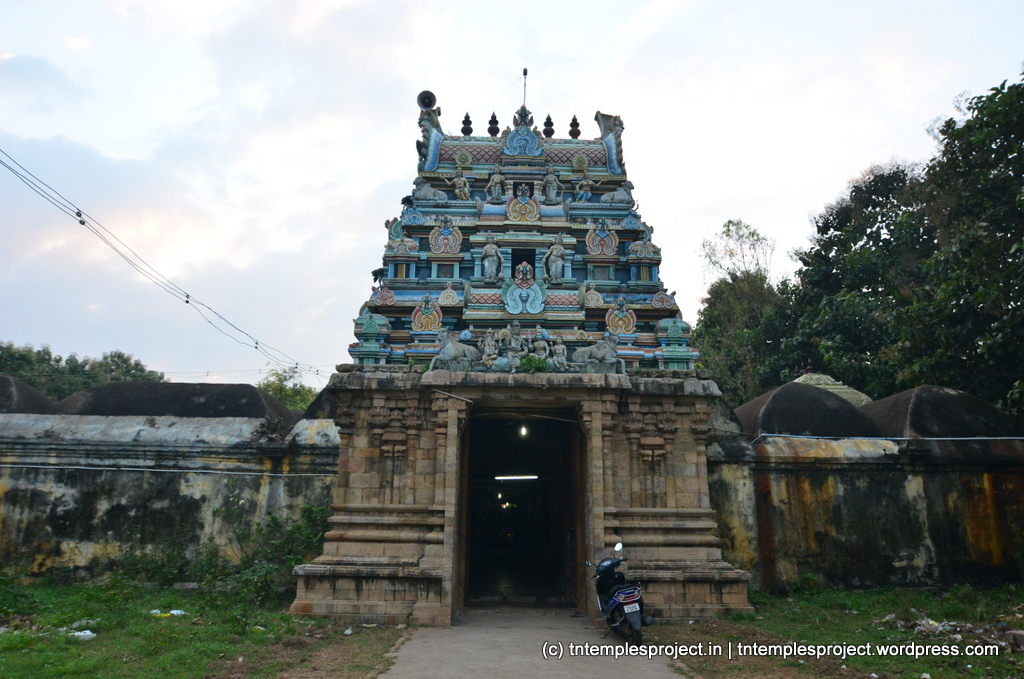Basic information about the temple
| Moolavar: | Akshayanatha Swami | Ambal / Thayar: | Yoga Nayaki |
| Deity: | Vaippu Sthalam | Historical name: | |
| Vriksham: | Teertham: | ||
| Agamam: | Age (years): | ||
| Timing: | 8 to 12 & 5 to 7.30 | Parikaram: | |
| Temple group: | Vaippu Sthalam | – | |
| Sung by: | Temple set: | ||
| Navagraham: | Nakshatram: | ||
| City / town: | Tirumandurai | District: | Thanjavur |
| Maps from (click): | Current location | Kumbakonam (17 km) | Mayiladuthurai (22 km) |
| Tiruvarur (41 km) | Ariyalur (57 km) |
Location
Sthala puranam and temple information

Parvati once made fun of sage Suka, and was cursed by Siva to be born as a parrot on Bhulokam. She prayed to Siva, who instructed her to locate a swayambhu murti of Siva at Aamravanam, and worship Him there. She did so, and was eventually reunited with the Lord, who married Her here. Hence Amman’s shrine here is a separate one, to the right of the moolavar shrine, representing their kalyana kolam.
Similarly, sage Galva and also the Navagrahams were afflicted with leprosy. They came to know about Parvati being blessed and relieved from Her curse here, and so they came here and worshipped Siva for a fortnight, after which they were all cured. For this reason, this temple is a Navagraha dosha nivritti sthalam. (It is believed that this incident occurred in the middle of the Tamil month of Margazhi (December-January), and that the sage remarked that after the fortnight, ie at the beginning of the month of Thai, there would be a positive change in their situation. This is believed to have led to the Tamil aphorism தை பிறந்தால் வழி பிறக்கும், meaning once the month of Thai commences, there will be a positive change.)
They also gave the appellation of Akshayanathar to Siva, and Yogambal to Amman here. Akshaya means prosperity (or rather, not having a deficit, or a-kshaya). Amman was named Yogambal because it was their fortune (yogam) that they could follow Her path and come here for relief.
Indra and Varuna worshipped Him here and regained their wealth and prosperity, after the celestial world once faced severe hardship due to drought. Because this used to be a mango forest (Aamravanam in Sanskrit), it is called Maan-thurai in Tamil.
There are two sthala puranams connected with this temple, that relate to Chandran. First, because he was present at Daksha’s yagam, Chandran (the moon) was cursed that his body would waste away gradually, resulting in him losing his lustre over time. The other is the favouritism Chandran showed towards Rohini, because of which at their father Daksha’s advise, the other 27 wives of Chandran cursed that he (Chandran) would lose his beauty. In any event, Chandran started to wane in his lustre. Worried about this, he consulted Brhaspati, who advised Chandran to visit a mango forest called Aamravanam on the banks of the Kaveri river, for his penance. Chandran did so, and was blessed by both Siva, and Vinayakar in the form of Uchishta Ganapati.
Chandran also received a boon that those worshipping here on Mondays (associated with Chandran) would be blessed with happiness and prosperity. For this reason, this temple is a Chandra dosha parikara sthalam. Also connected with Chandran, this temple is beneficial for worship, for those under the Rohini nakshatram (waxing phase) and Virschika rasi (waning phase).
In the Mahabharatam, the Pandavas are believed to have worshipped here during their period of exile.

This is one of the Vaippu sthalams in the Tevaram, and Sambandar has referred to this temple in one of his hymns. In addition, it is one of the seven temples that comprise the Sapta Sthanam temples associated with Kanjanoor Agneeswarar temple, which are:
- Abatsahayeswarar, Thenkurangaduthurai, Thanjavur
- Gomukteeswarar, Tiruvavaduthurai, Thanjavur
- Agneeswarar, Kanjanoor, Thanjavur
- Tirukoteeswarar, Tirukodikkaa, Thanjavur
- Prananatheswarar, Tirumangalakudi, Thanjavur
- Akshayanatha Swami, Tirumandurai, Thanjavur (this temple)
- Vataranyeswarar, Tiruvalangadu, Tiruvarur
The temple is closely associated with Hara Datta, an ardent Siva devotee who was born in a staunch Vaishnavite family. He is also associated with several of the above-mentioned Kanjanoor Sapta Sthanam temples.
The core temple is believed to have been here for over 3,800 years, as a swayambhu murti. The structural temple is a medieval Chola temple, dating back to the late 10th century / early 11th century, at which time it was a brick temple, before being renovated as a stone structure by Sembian Madevi, wife of Gandaraditya Chola.
The moolavar’s garbhagriham faces east. Amman has a separate shrine to the right of the moolavar. The temple is also famous for Uchishta Ganapati, who has a separate shrine between the Siva and Parvati shrines here. See this video of the temple Sivacharyar talking about Uchishta Ganapati.
Because of the connection with the Navagrahams in the sthala puranam of this temple, there is no separate Navagraham shrine here.
Sage Galva and the Navagrahams took a bath in the temple’s tank – the Chandra Teertham. In keeping with the temple’s theme of akshayam, the temple tank never goes dry. What’s even more interesting, is that the water level in the temple’s tank is said to rise during the waxing phase of the moon, and fall during the waning phase.
Other information for your visit
Contact
Raju Sivacharyar: 9994032380
Gallery

















